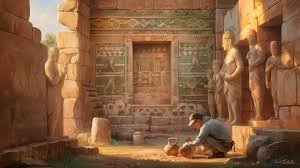Introduction
Envision strolling through the remnants of old ancient artz human progress, following your fingers along the endured stone of a model that has gone the distance. Old craftsmanship enthralls us with its excellence, secret, and the accounts it tells about individuals who made it. This blog entry will take you on an intriguing excursion through history, investigating the bait of old workmanship and its immortal allure. We’ll uncover its importance, inspect the imaginative methods utilized by old craftsmen, and examine how it proceeds to motivate and connect with us today. Whether you’re a craftsmanship fan, a set of experiences buff, or a social pilgrim, this profound jump into old workmanship vows to illuminate and charm.
Defining Ancient Artz
Old craftsmanship includes many innovative articulations from various societies and time spans. It incorporates visual expressions like artistic creation and figures and design and improving expressions. These works give us important experiences in the social orders that created them, mirroring their convictions, values, and daily existence. From the magnificent pyramids of Egypt to the complicated stoneware of old Greece, each piece of old craftsmanship recounts an extraordinary story and adds to how we might interpret mankind’s set of experiences.
Visual expressions in antiquated times were frequently made for strict or stately purposes. For instance, Egyptian artistic creations portrayed scenes from eternity to direct the departed on their excursion. Essentially, Pompeii’s frescoes depict the Romans’ regular routines and strict customs. Figures, as well, assumed a critical part in old craftsmanship, with famous models like the sculptures of Greek divine beings and goddesses, which were imaginative show-stoppers as well as images of social personality and strict dedication.
Engineering is one more critical part of old craftsmanship. The magnificence of designs like the Parthenon in Athens or the Colosseum in Rome exhibits the high-level designing and creative abilities of antiquated human advancements. These compositional wonders were frequently enhanced with mind-boggling carvings and figures, mixing usefulness with stylish excellence. Enlivening expressions, including mosaics, stoneware, and gems, further show the inventiveness and craftsmanship of old craftsmen.
The Significance of Ancient Artz
Old workmanship holds huge social, authentic, and creative significance. It fills in as a window into the past, permitting us to associate with the contemplations, feelings, and encounters of individuals who lived millennia prior. These show-stoppers give important experiences into the social, political, and strict elements of antiquated social orders, assisting us with figuring out the groundwork of our cutting-edge world.
Socially, old craftsmanship was a method for correspondence and articulation. It conveyed strict convictions, social progressive systems, and shared values. For example, the cavern compositions of Lascaux in France portray creatures and hunting scenes, offering a brief look into the regular routines and otherworldly acts of early people. The intricate burial chamber works of art in old Egypt show the significance of the hereafter and the confidence in everlasting status.
All things considered, old craftsmanship is a record of critical occasions and accomplishments. The reliefs on the walls of Assyrian castles portray military victories and regal services, giving significant data about the realm’s set of experiences and administration. The many-sided carvings on the sanctuaries of Angkor in Cambodia portray the narratives of Hindu and Buddhist folklore, saving the social legacy of the Khmer Realm.
Imaginatively, antiquated workmanship proceeds to move and impact contemporary specialists and planners. The methods and styles created by old craftsmen established the groundwork for different imaginative developments from the beginning of time. For instance, Greek figures’ authenticity and vision lastingly affect Western workmanship. Using point of view and extent in old Roman frescoes prepared for the Renaissance and ensuing creative headways.
A Journey Through Time
Traveling through time, we experience notable bits of old craftsmanship that have permanently imprinted on history. Every human progress has contributed special and powerful fine arts that continue to impact us today. How about we investigate some of these exceptional manifestations and their persevering through heritages?
One of the most unmistakable pieces is the Incomparable Sphinx of Giza in Egypt. This titanic limestone sculpture, with the body of a lion and the top of a pharaoh, remains as an image of solidarity and insight. It has interested antiquarians and archeologists for a long time, rousing endless speculation about its motivation and development.
From old Greece, the Parthenon figures, or the Elgin Marbles, demonstrate the imaginative virtuoso of the Old-style time frame. These marble molds once enhanced the Parthenon sanctuary in Athens and portrayed different divine beings, goddesses, and legendary scenes. Their complicated subtleties and similar structures keep on enamoring crowds in historical centers all over the planet.
In old China, the Earthenware Armed Force is a surprising illustration of funerary craftsmanship. Found in the burial chamber of Ruler Qin Shi Huang, this immense assortment of life-sized earth troopers, ponies, and chariots was made to go with the sovereign in eternity. Each figure is interestingly itemized, exhibiting the high-level craftsmanship of old Chinese craftsmen.
Old Mesoamerican civic establishments likewise created remarkable workmanship, for example, the Mayan stelae. These complicatedly cut stone landmarks recognize significant occasions and rulers, giving important bits of knowledge about Mayan history and culture. The point by point symbolic representations and portrayals of customs offer a brief look into the otherworldly and political existence of the Maya.
The Evolution of Techniques
Antiquated craftsmen were trailblazers of imaginative procedures that have molded the course of workmanship history. They explored different avenues regarding different materials, devices, and strategies to persevere through works of art. How about we investigate some of these notable procedures and their effect on the world of craftsmanship?
Greek stone workers, known for their dominance of marble, created procedures like contrapposto, where figures are portrayed in a naturalistic position with weight moved onto one leg. This method added a feeling of development and authenticity to their sculptures, impacting the resulting ages of specialists.
In old Rome, fresco painting turned into a well known strategy for enhancing walls and roofs. Craftsmen applied shades onto wet mortar, making dynamic and strong wall paintings. The many-sided frescoes of Pompeii, saved by the emission of Mount Vesuvius, give a striking look into Roman life and feel.
The old Egyptians consummated the specialty of alleviation cutting, utilizing it to embellish sanctuaries, burial places, and landmarks. Frequently painted in brilliant tones, these carvings portrayed divine beings, pharaohs, and scenes from day-to-day existence. The exact lines and nitty gritty structures grandstand the ability and accuracy of Egyptian craftsmen.
Mayan craftsmen created progressed methods for working with jade, obsidian, and other valuable materials. They made complex adornments, stylized articles, and models, showing their uncommon craftsmanship and tender loving care. Using decorating and mosaic methods added a special style to their works.
The Digital Age and Ancient Artz
In the present computerized age, innovation has upset the manner in which we access and draw in with old craftsmanship. Computerized devices and stages have made it simpler to investigate, protect, and decipher these immortal show-stoppers. We should inspect what innovation has meant for the universe of antiquated workmanship.
In the present computerized age, innovation has upset the manner in which we access and draw in with old craftsmanship. Computerized devices and stages have made it simpler to investigate, protect, and decipher these immortal show-stoppers. We should inspect what innovation has meant for the universe of antiquated workmanship.
Computerized reclamation strategies have likewise assumed an essential part in saving old craftsmanship. High-level imaging and 3D filtering advancements empower conservators to break down and reestablish disintegrating fine arts with accuracy. For instance, 3D models of old figures can be made to concentrate on their unique structures and varieties.
Expanded reality (AR) and augmented reality (VR) encounters offer vivid ways of drawing in with antiquated workmanship. Guests can utilize AR applications to perceive how old destinations and antiquities are searched in their unique settings. VR encounters, such as visiting the remnants of old Rome, give a feeling of presence and association with the past.
Innovation has likewise improved insightful exploration and translation of antiquated workmanship. Computerized data sets and artificial intelligence-fueled apparatuses permit analysts to investigate huge volumes of information, revealing new bits of knowledge and associations. For example, simulated intelligence calculations can distinguish designs in antiquated texts and works of art, assisting history students with translating their implications.
Preserving the Past for the Future
Saving old workmanship presents huge difficulties, however continuous preservation endeavors expect to safeguard these fortunes for people in the future. We should investigate the significance of protection and the creative strategies used to defend old workmanship.
Ecological elements, like dampness, temperature changes, and contamination, can cause the disintegration of antiquated fine art. Conservators use environment-controlled conditions and high-level observing frameworks to shield curios from these dangers. Also, defensive coatings and medicines are applied to forestall further harm.
Human exercises, including plundering and defacing, present critical dangers to old craftsmanship. Global associations, for example, UNESCO, work to battle the unlawful dealing of social antiques and advance the security of legacy destinations. Public mindfulness crusades and lawful systems are fundamental in protecting these social fortunes.
A joint effort between establishments, specialists, and nearby networks is imperative for successful conservation. Protection projects frequently include interdisciplinary groups, including archeologists, physicists, and workmanship history specialists. By consolidating their skill, they foster exhaustive systems for protecting and reestablishing old workmanship.
Training and public commitment likewise play a vital part in safeguarding endeavors. Historical centers and social associations offer instructive projects and presentations to bring issues to light about the significance of safeguarding antiquated workmanship. By encouraging a feeling of obligation and appreciation, they move people in the future to esteem and safeguard these social fortunes.
Appreciating Ancient Artz Today
In the present high-speed world, antiquated workmanship proceeds to charm and rouse us. We should investigate how present-day culture draws in and values these immortal works of art.
Workmanship exhibition halls and displays give valuable chances to individuals to encounter old craftsmanship firsthand. Presentations, including notorious relics and vivid showcases, permit guests to interface with the past. Establishments like the Metropolitan Gallery of Workmanship and the English Exhibition Hall curate displays that feature the social and authentic meaning of antiquated craftsmanship.
Public workmanship establishments and copies bring old craftsmanship into public spaces, making it open to a more extensive crowd. For instance, the imitation of Michelangelo’s David in Florence permits guests to see the value in the glory of this magnum opus without venturing out to Italy. These drives cultivate a more profound appreciation for old workmanship in day-to-day existence.
Contemporary specialists frequently draw motivation from antiquated craftsmanship, integrating its procedures and subjects into their work. By reconsidering old themes and styles, they make an exchange between the past and the present. This combination of old and new improves the craftsmanship world and keeps antiquated workmanship applicable in present day times.
Craftsmanship schooling projects and studios acquaint youthful students with the miracles of antiquated workmanship. Schools and social associations offer classes and exercises investigating different imaginative practices and procedures. By supporting imagination and interest, these projects create a long-lasting appreciation for craftsmanship and culture.
Conclusion
Old workmanship is something other than a brief look into the past; it demonstrates human inventiveness, development, and articulation. Its ageless allure dazzles and moves us, offering important experiences into the way of life and social orders that preceded us. By saving and valuing antiquated craftsmanship, we honor our common legacy and guarantee that people in the future can encounter its miracles.
Whether you’re a workmanship fan, history buff, or social pioneer, there are incalculable ways of drawing in with old craftsmanship. Visit historical centers, investigate virtual displays, and participate in instructive projects to develop your comprehension and appreciation. Join conversations, share your encounters, and urge others to find the magnificence and meaning of antiquated workmanship.
How about we commend the persevering the tradition of old workmanship and focus on safeguarding it for what’s in store? Together, we can guarantee that these immortal works of art proceed to move and enhance our lives for a long time into the future.



